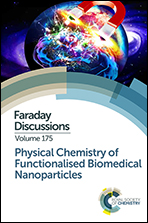单分子荧光的电化学调制
IF 3.3
3区 化学
Q2 CHEMISTRY, PHYSICAL
引用次数: 0
摘要
本文介绍了我们发现的一种在荧光亮态和暗态之间调节荧光团的电化学方法。我们展示了如何利用存在于氧清除剂缓冲液中的氧化还原活性介质,通过电化学方法有效调节铟锡氧化物表面上有机染料标记细胞样本的荧光强度。我们的研究表明,电化学荧光调制对外加电位和激发激光强度很敏感,这表明有可能发生光化学反应和电化学反应耦合。我们还使用 ATTO 655、Alexa Fluor 488 和 Alexa Fluor 647 比较了具有代表性的噁嗪、罗丹明和青染料的电化学荧光调制。具有明显不同结构核心的不同染料显示出不同程度的荧光调制。电化学荧光调制将适用于荧光成像技术和生物传感。本文章由计算机程序翻译,如有差异,请以英文原文为准。
The electrochemical modulation of single molecule fluorescence
Herein is presented our discovery of an electrochemical approach for modulating fluorophores between fluorescent bright states and dim states. We demonstrate how to effectively modulate the fluorescent intensity of organic dye-labelled cell samples on an indium tin oxide surface using electrochemistry with redox-active mediators present in an oxygen scavenger buffer. We showed the electrochemical fluorescence modulation is sensitive to the applied potential and the excitation laser intensity, indicating the possibility of coupled photochemical and electrochemical reactions occurring. We also compared the electrochemical fluorescence modulation of representative oxazine, rhodamine, and cyanine dyes using ATTO 655, Alexa Fluor 488, and Alexa Fluor 647. Different dyes with distinctly different structural core show fluorescence modulation to different extents. The electrochemical fluorescence modulation will be applicable in fluorescence imaging techniques as well as biosensing.
求助全文
通过发布文献求助,成功后即可免费获取论文全文。
去求助
来源期刊

Faraday Discussions
化学-物理化学
自引率
0.00%
发文量
259
期刊介绍:
Discussion summary and research papers from discussion meetings that focus on rapidly developing areas of physical chemistry and its interfaces
 求助内容:
求助内容: 应助结果提醒方式:
应助结果提醒方式:


